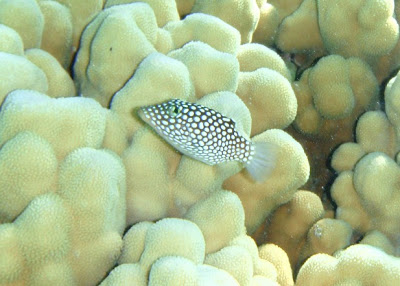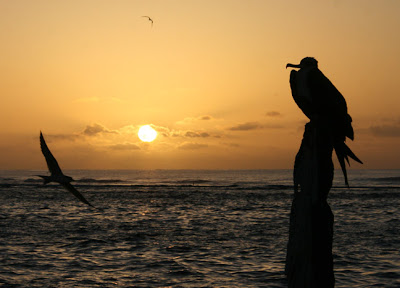We also took a boat trip to the southern tip of the atoll, to Disappearing Island. It's there most of the time, but not always. The water is beautiful down there, so we had to have a look around. There are a few pictures below.
The Hi'ialakai stopped in again on its way back down to Honolulu. They're still doing reef surveys and more maritime archeological work on the shipwrecks around here. A few of the researchers and crew got to visit the island this time. They rarely get the chance to step on island, but the ocean swells were sort of high, making diving difficult, so they had a little extra time.
Other than that, we've got the usual stuff going on around here. Lots of chicks, lots of eggs of different species, and lots of noise from the sooty terns.
 One of the small boats from the Hi'ialakai is dropping off a group of visitors to see the island.
One of the small boats from the Hi'ialakai is dropping off a group of visitors to see the island. Clockwise from left are Sarah, Dasha, me, Tammy, and Ruth with Disappearing Island above the waterspot on the left of the picture (photo courtesy of Caitie Kroeger).
Clockwise from left are Sarah, Dasha, me, Tammy, and Ruth with Disappearing Island above the waterspot on the left of the picture (photo courtesy of Caitie Kroeger). Disappearing Island is relatively large right now but may be gone in a month or two, but then again, it may not.
Disappearing Island is relatively large right now but may be gone in a month or two, but then again, it may not. An old lobster trap still sits on the bottom near the island. The black fish are Achille's tangs, and the yellow one is a relatively recent introduction to the Hawaiian Islands (1958). It is a bluestripe snapper. My underwater camera is off for repairs, so I borrowed Caitie's camera to take all of these pics.
An old lobster trap still sits on the bottom near the island. The black fish are Achille's tangs, and the yellow one is a relatively recent introduction to the Hawaiian Islands (1958). It is a bluestripe snapper. My underwater camera is off for repairs, so I borrowed Caitie's camera to take all of these pics. Here's a chevron butterflyfish. These are very rare in the Hawaiian archipelago, but fairly common here because they only eat (genus) Acropora coral, commonly called table coral, seen here just behind the fish. Acropora coral is only common in Hawaii at French Frigate Shoals.
Here's a chevron butterflyfish. These are very rare in the Hawaiian archipelago, but fairly common here because they only eat (genus) Acropora coral, commonly called table coral, seen here just behind the fish. Acropora coral is only common in Hawaii at French Frigate Shoals.  Here are a couple more Achille's tangs, yellow tangs, and ornate butterflyfish about 20 ft down.
Here are a couple more Achille's tangs, yellow tangs, and ornate butterflyfish about 20 ft down. Here's the reverse view that the volunteers see out their windows.
Here's the reverse view that the volunteers see out their windows. The wedge-tailed shearwaters really like to nest in the boat house. It's far nicer than their usual burrows. It makes the boat difficult to take out, and we frequently have to scoot the eggs out from under the trailer tires. At least these birds are pretty good at knowing they are supposed to move. The albatross chicks just sit and snap at the trailer, thinking that that'll scare it away or make it turn around.
The wedge-tailed shearwaters really like to nest in the boat house. It's far nicer than their usual burrows. It makes the boat difficult to take out, and we frequently have to scoot the eggs out from under the trailer tires. At least these birds are pretty good at knowing they are supposed to move. The albatross chicks just sit and snap at the trailer, thinking that that'll scare it away or make it turn around.



 Here it is from the reverse side. It may have been injured when it was young to get that pattern, or it may just be genetically different from the normal ones. It's hard to get a close look at them.
Here it is from the reverse side. It may have been injured when it was young to get that pattern, or it may just be genetically different from the normal ones. It's hard to get a close look at them.
 The Hi'ialakai stays pretty far out to sea so they don't hit any of our reef. The "Oscar Elton Sette" looks the same, but I might have some closer pics of that next week.
The Hi'ialakai stays pretty far out to sea so they don't hit any of our reef. The "Oscar Elton Sette" looks the same, but I might have some closer pics of that next week. This is one of the safeboats from the Hi'ialakai. They were checking to see what was growing on our seawall. It usually takes me a year or two to get the data that they collect on these trips. I normally get that when the publications come out, so don't ask me what they found yet.
This is one of the safeboats from the Hi'ialakai. They were checking to see what was growing on our seawall. It usually takes me a year or two to get the data that they collect on these trips. I normally get that when the publications come out, so don't ask me what they found yet. This is a young bluespine unicornfish. It will grow a long "horn" in front of it's eyes as it gets older. The blue spines are just barely visible near its tail (on the caudal peduncle for those that know what that is). Those are the fish's defense. I have a couple of pictures of the adults, which get about 2 ft long, but they aren't as close so they aren't that nice to look at.
This is a young bluespine unicornfish. It will grow a long "horn" in front of it's eyes as it gets older. The blue spines are just barely visible near its tail (on the caudal peduncle for those that know what that is). Those are the fish's defense. I have a couple of pictures of the adults, which get about 2 ft long, but they aren't as close so they aren't that nice to look at. This is a Hawaiian whitespotted toby. These little fish are pretty much everywhere around here. I've been putting more fish pictures up lately because the water is finally calming down for the summer and we've been going snorkeling more often.
This is a Hawaiian whitespotted toby. These little fish are pretty much everywhere around here. I've been putting more fish pictures up lately because the water is finally calming down for the summer and we've been going snorkeling more often.
















